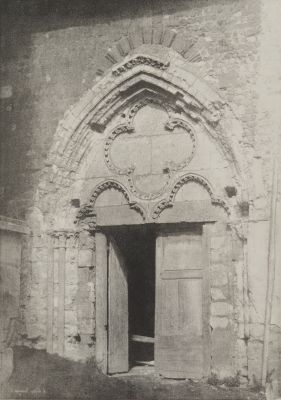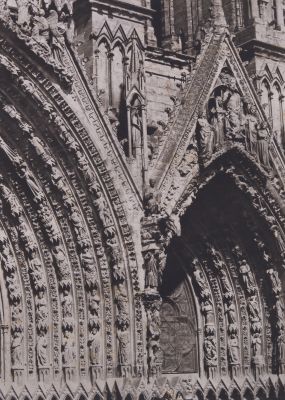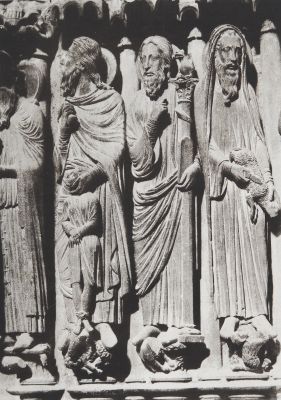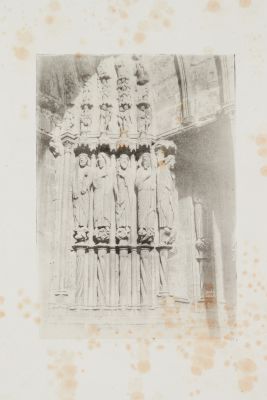
Title
Chartres, Cathedrale Notre-Dame, Ange au Cadran SolaireArtist
Le Secq, Henri (French, 1818-1882)Date
1852Process
Salt PrintImage Size
32.5 x 23.5 cm
“An icon of photomechanical reproduction.” Rosen
Henri Le Secq (1818–1882) was a French painter and photographer. Le Secq was one of five photographers selected by the French government to carry out a photographic survey of French architecture known as the Commission des Monuments Historiques or “missions héliographiques”. The project was established in 1851 to photograph landmarks and monuments around France so that they could be classified, protected, and restored. Le Secq photographed the Chartres cathedral for the commission. Although the French government never published the project, this Le Secq image, L’ange portant le cadran solaire, would soon take center stage in the photographic press as a test image for early experiments in photomechanical reproduction.
The image is of angel holding a sundial, which is inscribed with the date 1578. The image was chosen perhaps because the sundial aligns photography with the primitive clock, in that the raw materials for both the medieval sundial and the camera are sunlight and the passage of time. Or was it that the sundial made from stone was able to withstand the test of time as would be the photograph reproduced in printer’s ink? Or both? Whatever the reason, the sundial image quickly became the image used by inventors as a trial image to demonstrate new processes of reproduction.
This privileged role of L’ange in early photomechanical printing began with the development of photolithography by the print magnate Rose-Joseph Lemercier and his collaborators Lerebours, Barreswil and Davanne. Lithophotographie, as it was called at the time, was first reported to the Académie des Sciences on June 28, 1852 – just months after Le Secq made L’ange. Lemercier and crew continued to work on the process well into the next year, printing proofs to show to photographers and industrialists. While they reproduced many of Le Secq’s photographs, Lemercier chose as his signature image the view of L’ange. The print was included in a portfolio titled Lithophotographie, ou impressions obtenues sur pierre à l’aide de la photographie which was distributed to industrialists across Europe in 1853. L’ange was also featured as the first photomechanical image included in a printed journal in an 1854 issue of Bulletin de la Société d’encouragement pour l’industrie nationale.
After 1854, the image was printed in numerous photomechanical processes by different inventors. At the Exposition Universelle of 1855, "L’ange portant le cadran solaire" was displayed in three different locations, each representing three different graphic processes: the same image was exhibited as a salted-paper print, as a photolithograph, and as an image transferred onto a zinc plate called "litho-typo-gravure." Alphonse Poitevin, who introduced a rival process of photolithography in 1856, also used the same view of Chartres for one of his early reproductions. By the 1870s, LeSecq’s L’ange portant le cadran solaire was again reissued by the printer Thiel in a new series of photolithographs made as yet another printer’s portfolio.
On December 1, 1855, La Lumiere published a new photomechanical process by Dumont and a gravure to illustrate the process. Called zincographie galvanique, Dumont’s process transformed photolithographs into typographically-reproducible plates. The gravure used to accompany the article reproduced Lemercier’s print of the L’ange. Any mention of Le Secq as the author of the original photograph was omitted, as if this information was not relevant to the new printing technique sampled. La Lumiere praised the new invention and the print as the first means capable to print text and photograph together by letterpress. [1]
Reproduced / Exhibited
Borcoman, James. 19th-century French Photographs. Ottawa: National Gallery of Canada, 2010. fig. 35
La Lumière: Revue De La Photographie: Beaux-Arts, Héliographie, Sciences. Paris, 1851.
Lithophotographie: Ou Impressions Obtenues Sur Pierre À L’aide De La Photographie, 1er cahier, par MM. Lemercier, Lerebours, Barreswill et Davaime, Paris, Goupil, Gide & Baudry, London, Gambart, 1854.
Bulletin De La Société D’encouragement Pour L’industrie Nationale, Paris: La Société, 1854.
Le Secq H. Fragments d’architecture et sculpture de la cathédrale de Chartres d’après les clichés de Mr. Le Secq, artiste peintre ; et imprimés à l’encre grosse par Thiel âiné et Cie Editeurs à Bruxelles: Aug. Vandermolen, 1880.
References
[1] Rosen, H. Jeffrey, Lemercier & de: Photolithography and the Industrialisation of Print Production in France, 1837-1859, PhD dissertation, Evanston, Illinois, June 1988
Lewis JW. Charles Negre in Pursuit of the Photographic. 2012
Auer, Michel and Michelle Auer, Encyclopedie internationale des photographes de 1839 a nous jours, Paris, Camera ob-scura, 1985.
Bouquin, Corinne, Recherches suri ’imprimerie lithog raphique a Paris au XIXe siecle, L’imprimerie Lemercier (1803-1901), PhD dissertation, University of Paris I, December. 1993. Figuier, Louis, Les applications nouvelles de la science a l’industrie et aux arts en 1855, Paris, 1856.
Jammes, Andre, and Eugenia Parry Janis, The Art of French Calotype, Princeton, N. J,: Princeton University Press, 1983. Pinsard, Jules, L’illustration du livre moderne et la photographie, Paris, 1897.
Slythe, Margaret, The Art of Illustration: 1750-1900, London, 1970; Revue photographique. Chronique: Ateliers de M. Lemercier, no. 18, 5 avril 1857, 1.











